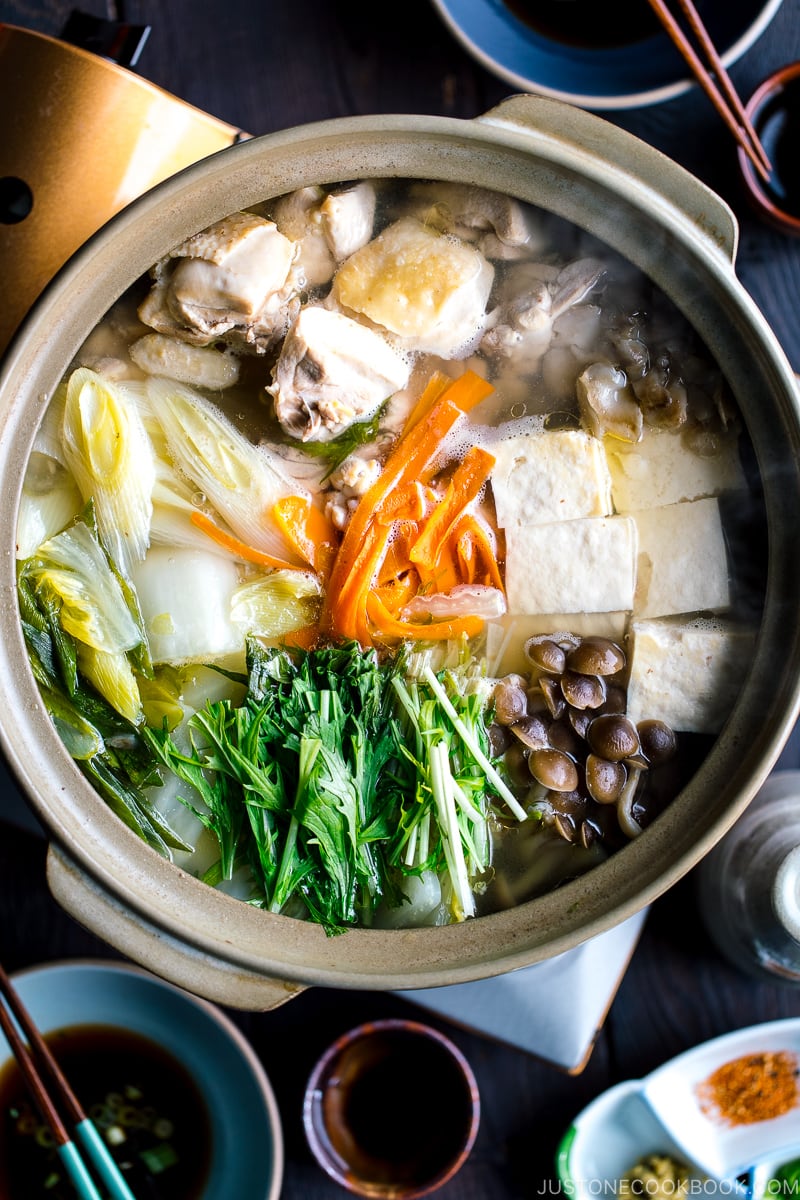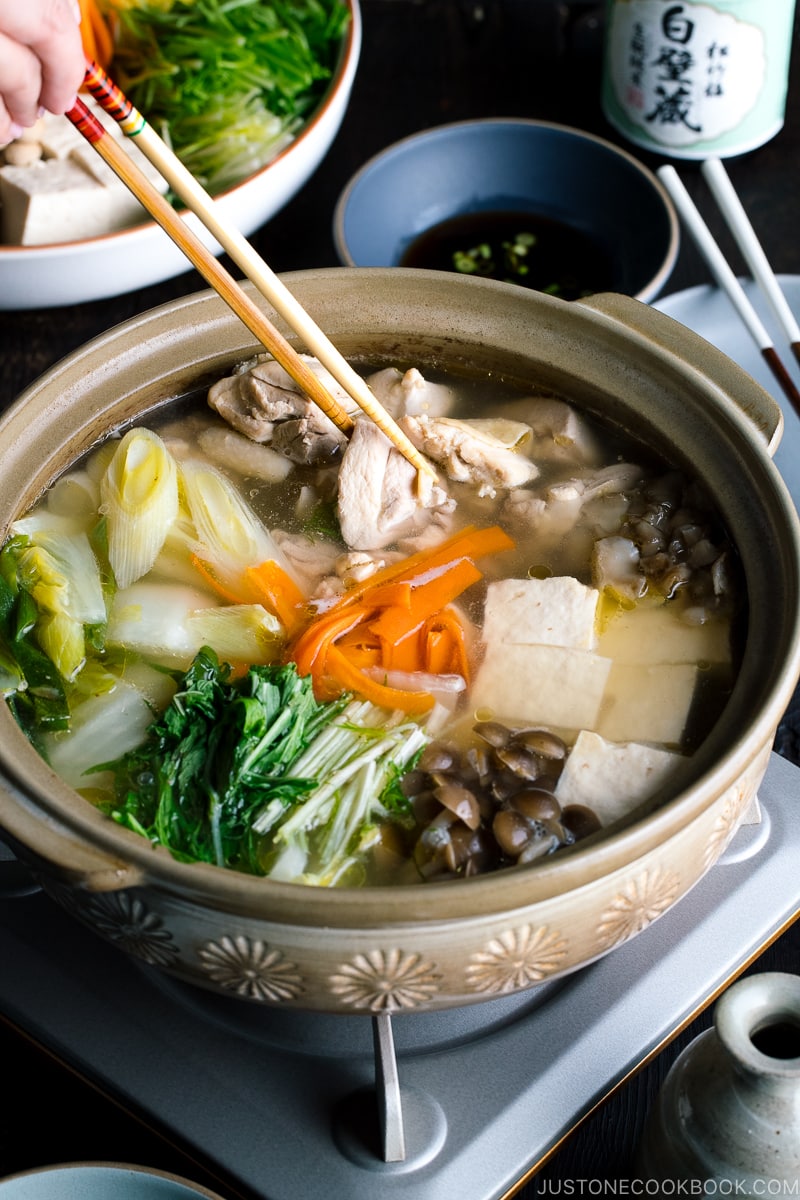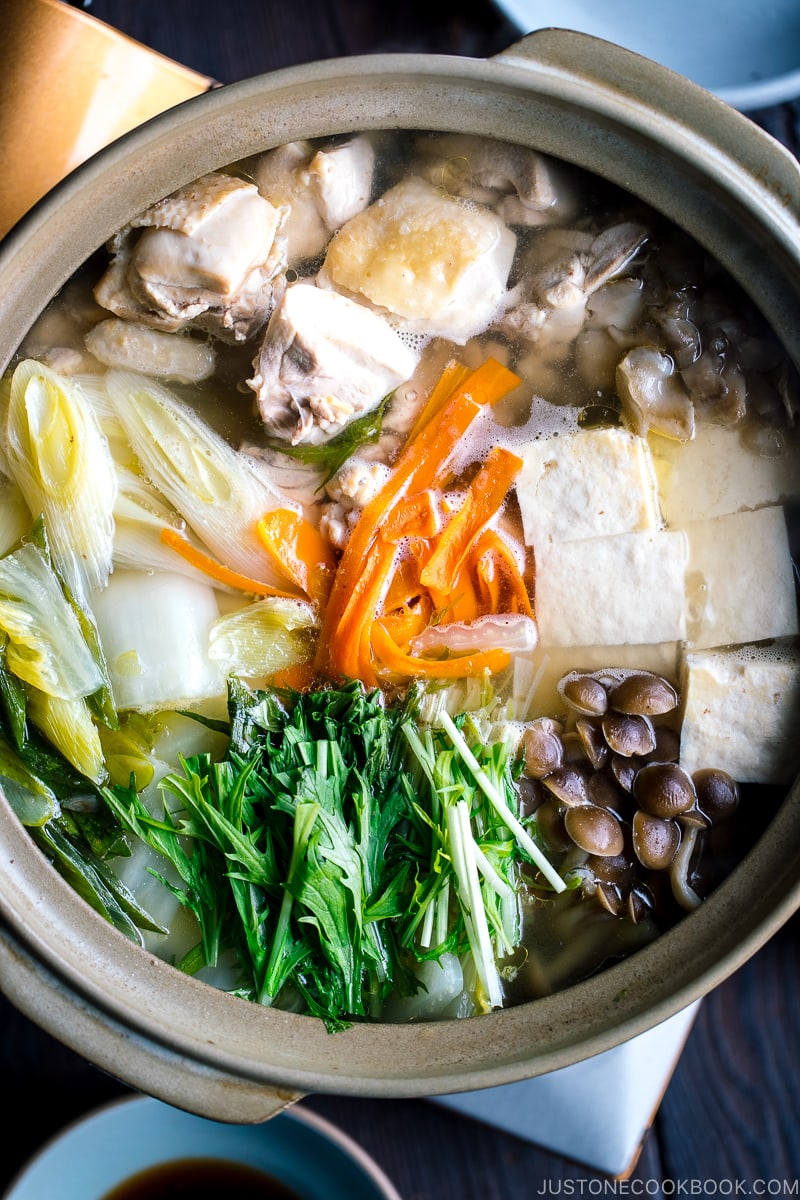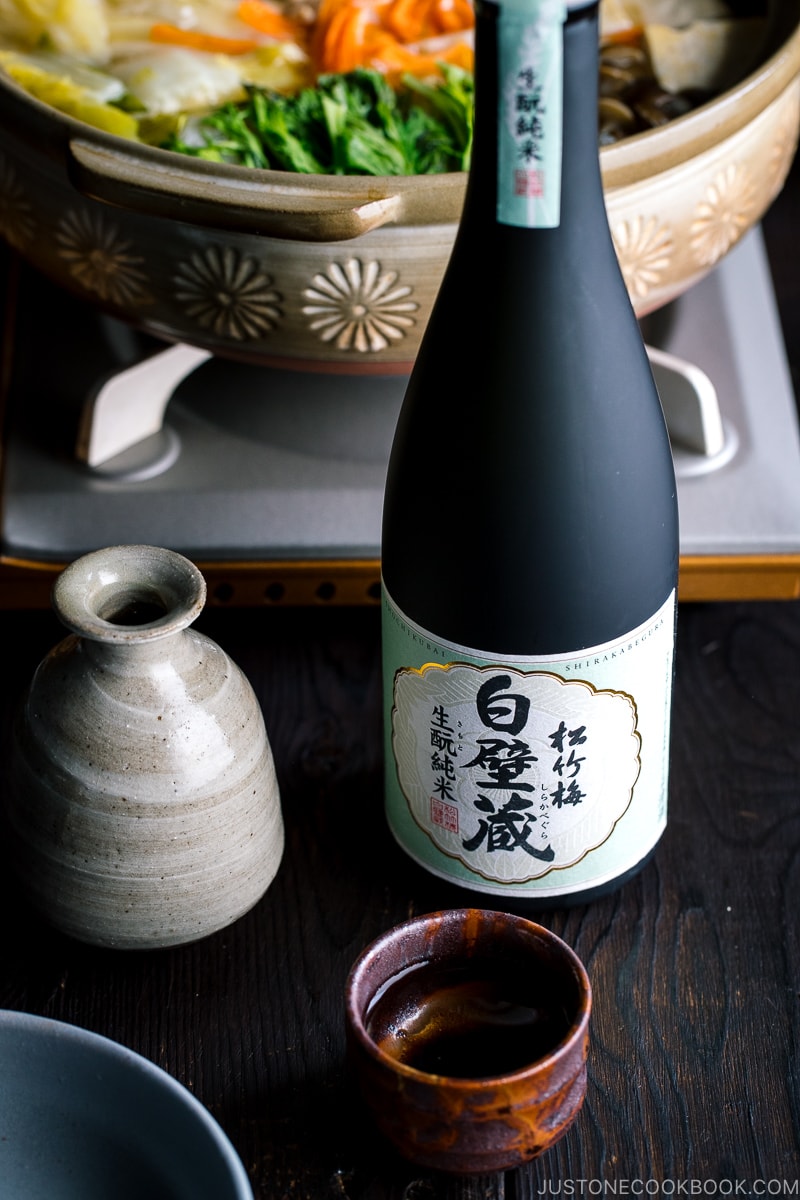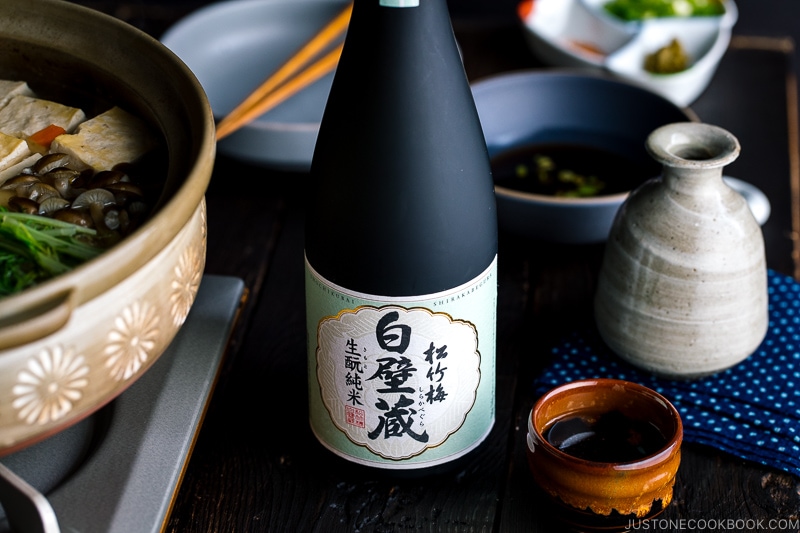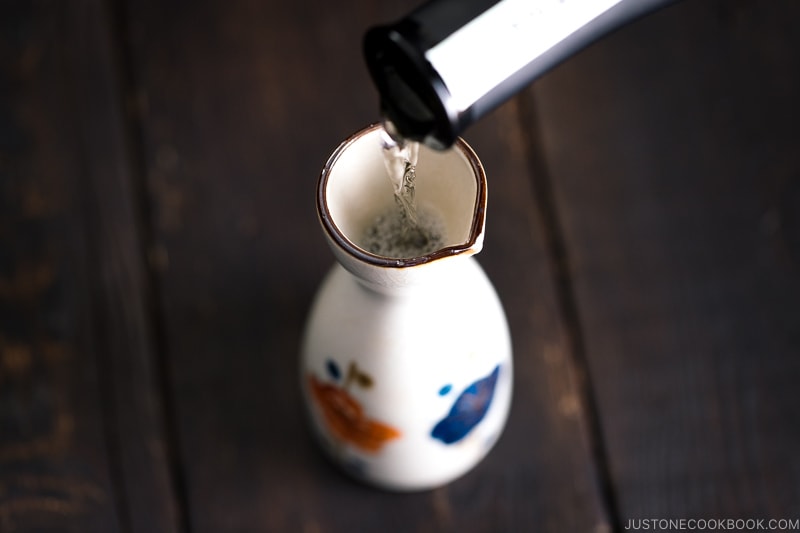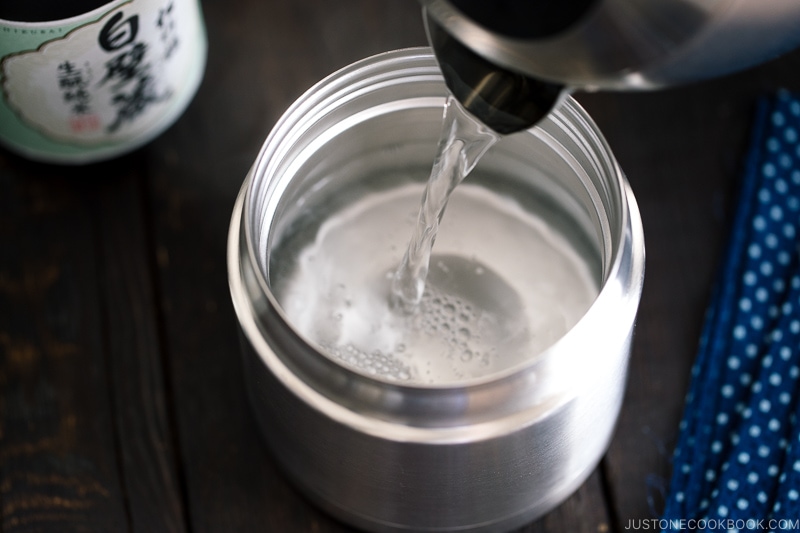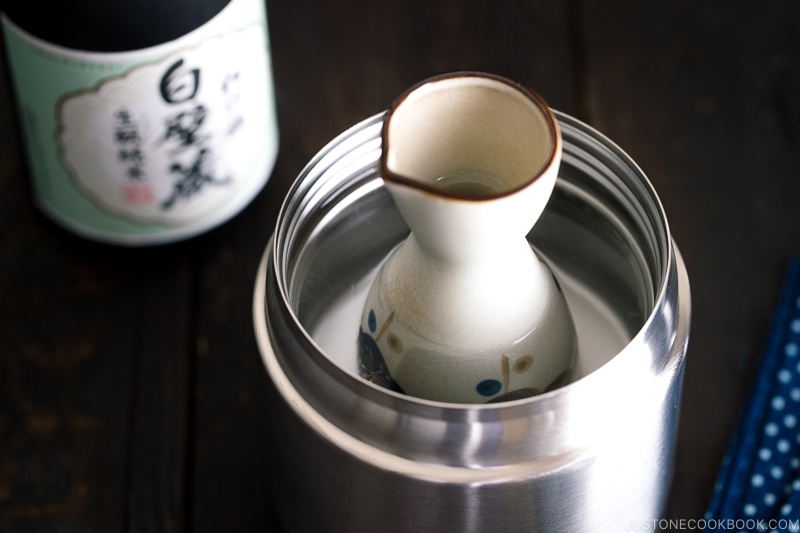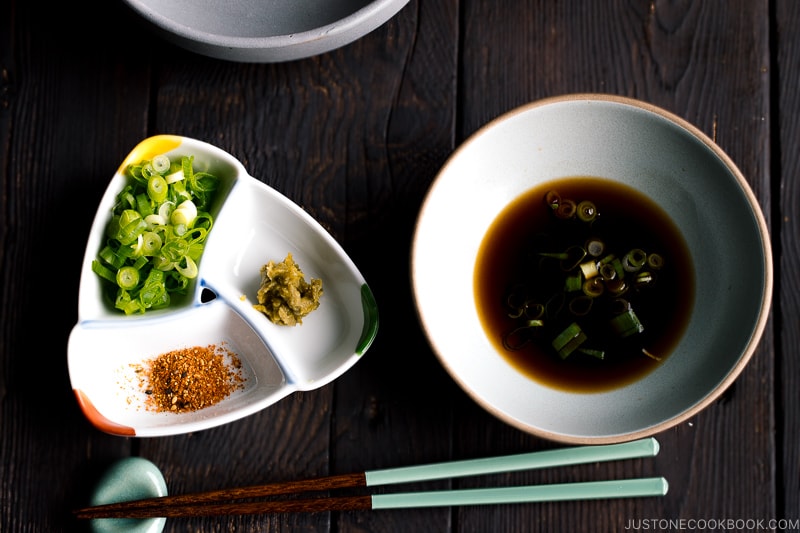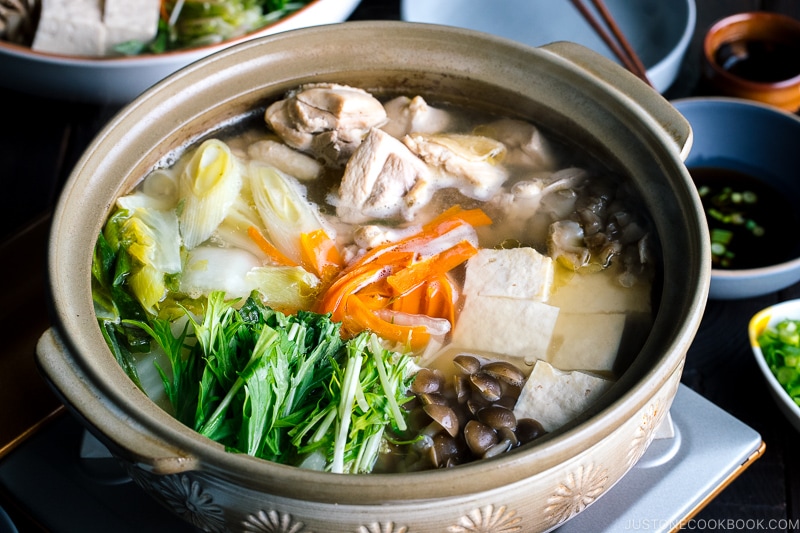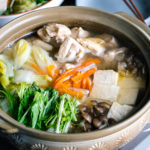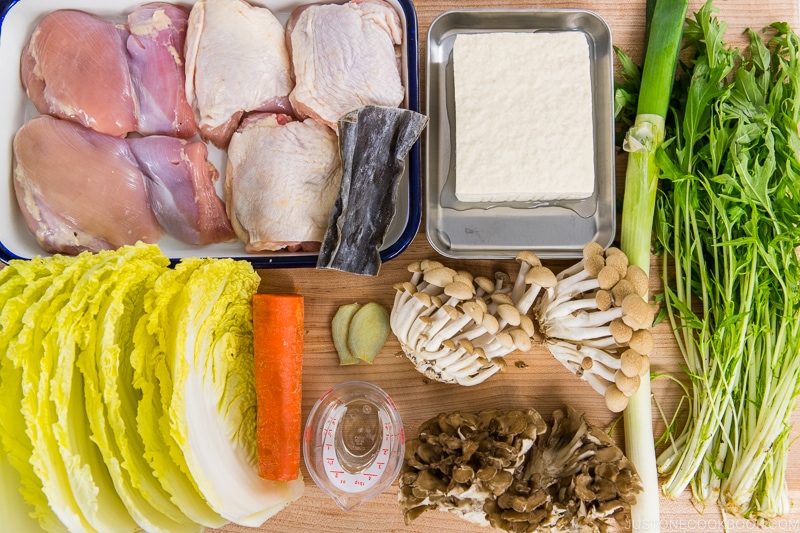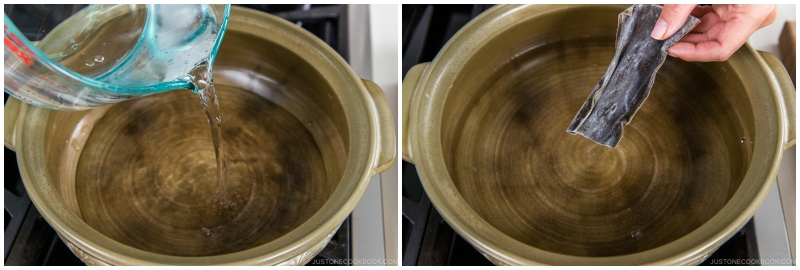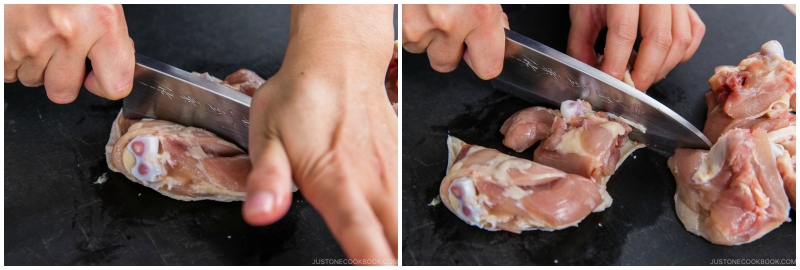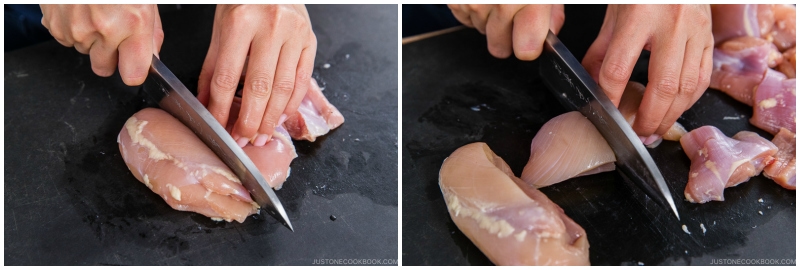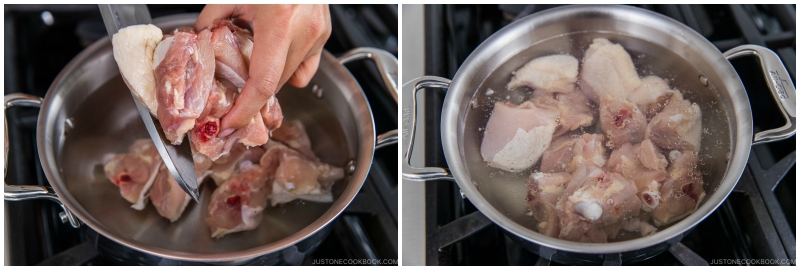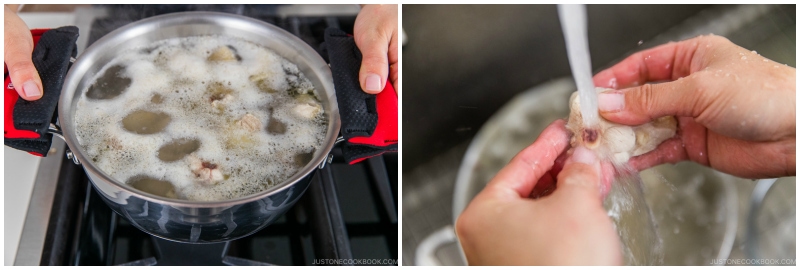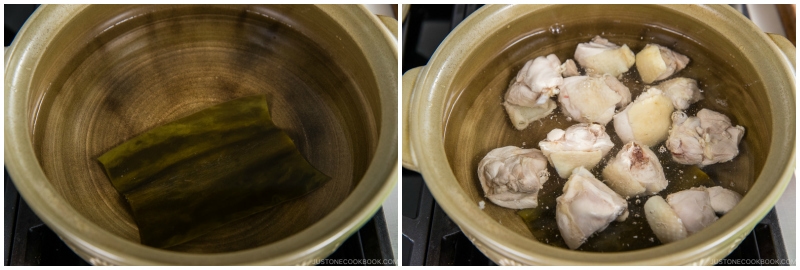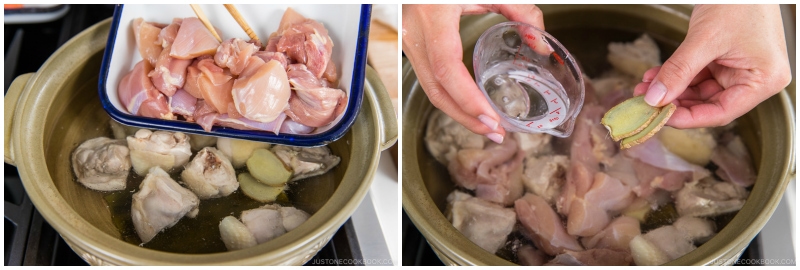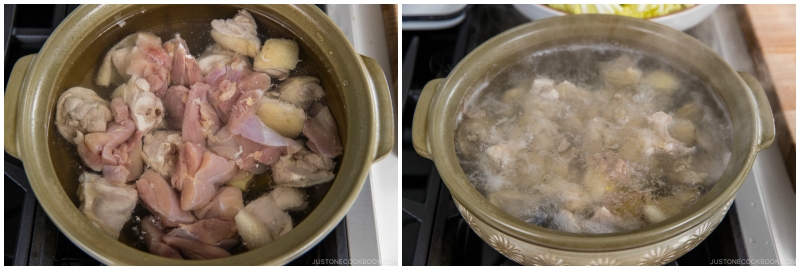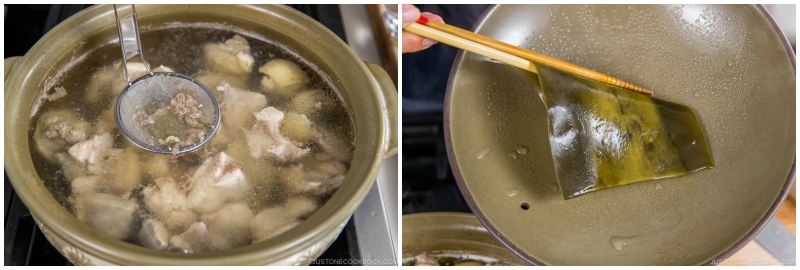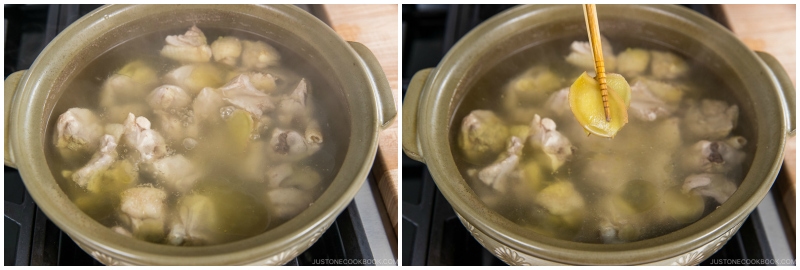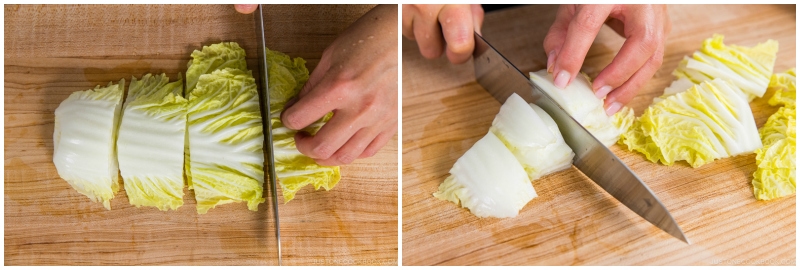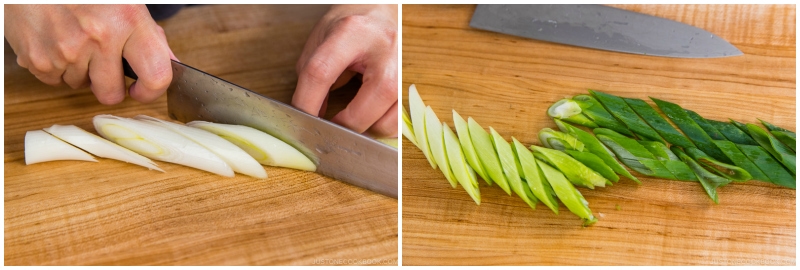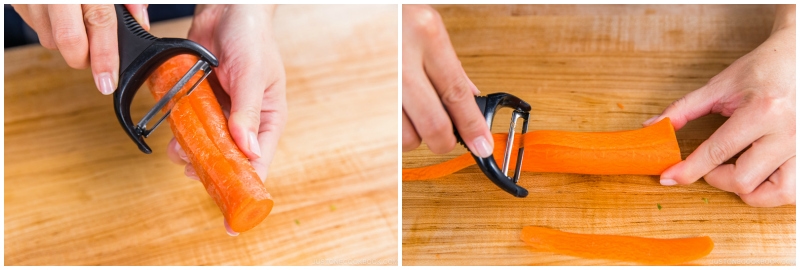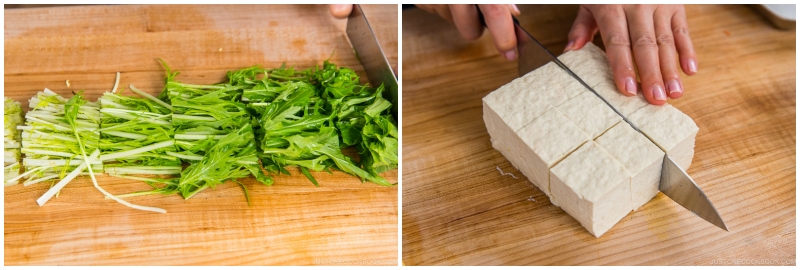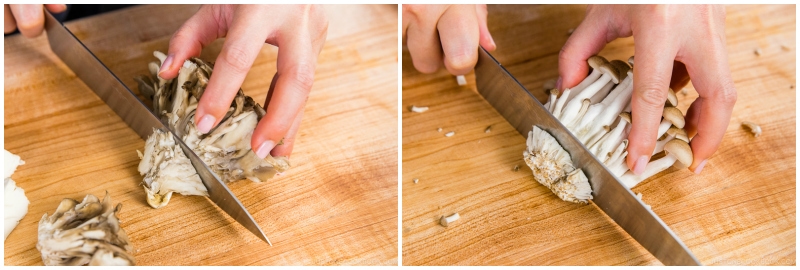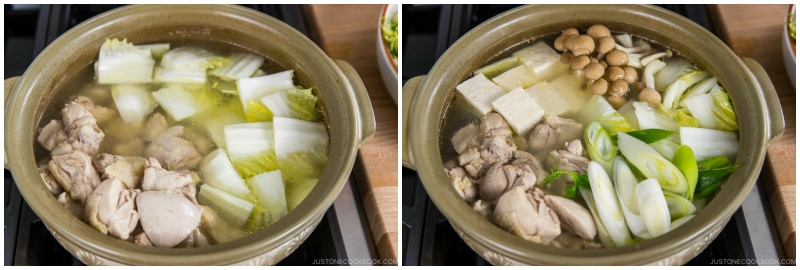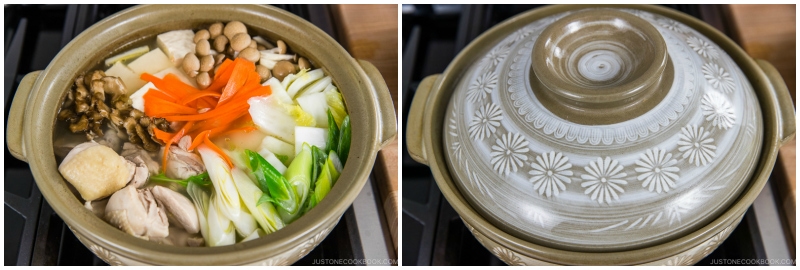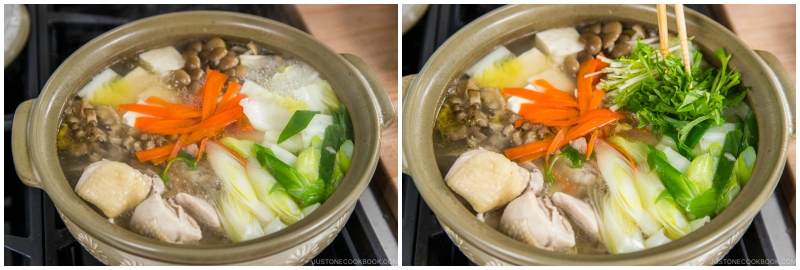What is Mizutaki?
Mizu (水) means water in Japanese and taki means simmering. As the name suggests, mizutaki is a Japanese hot pot dish where the ingredients, mainly chicken, are cooked in water or simple kombu dashi without any seasoning. Like other hot pot dishes, mizutaki is typically cooked communally at the table on a portable butane burner. It’s a treat on a wintery day when you enjoy good food and conversations with family and friends over a warm hot pot meal.
Mizutaki vs. Shabu Shabu: What’s the Difference?
At first glance, mizutaki may remind you of the most popular shabu shabu. Both hot pots are quite similar, but here are the main differences:
Shabu Shabu
The base of the soup broth is kombu dashi. Thinly sliced beef or pork is cooked in the broth along with other ingredients.
Mizutaki
The base of the soup broth is either water or kombu dashi. Chicken is cooked for a long time to make the soup broth prior to the meal. Minimal ingredients are used so they won’t overpower the rich, savory chicken soup.
A Regional Hot Pot from Kyushu and Kansai (Osaka)
Mizutaki originated mainly in the Kyushu and Kansai (Osaka) regions, but each region has its own version with different cooking methods.
Fukuoka/Kyushu-Style
Originally, water was used to cook the chicken. For a richer flavor, chicken bones were cooked in the water hours ahead to make the stock/broth. Due to this long cooking time, Kyushu-style mizutaki is known for its cloudy white chicken soup (白濁スープ). Uses bone-in, skin-on chicken thighs, and chicken meatballs. Other common ingredients include green cabbage (less moisture than napa cabbage), shungiku (chrysanthemum greens), long green onion (negi), tofu, and shiitake mushrooms. Dip in ponzu and yuzu kosho. Noodles are added to the soup at the end of the meal.
Osaka/Kansai-Style
Kombu dashi (water and dried kelp) is used for the broth. Chicken is used, but you can find pork as the main protein. Other ingredients include napa cabbage, shungiku (chrysanthemum greens), mizuna, spinach, long green onion (negi), tofu, aburaage (deep-fried tofu pouch), shiitake mushrooms, enoki mushrooms, daikon radish, carrot, and vermicelli (malony glass noodles). They vary slightly from home to home. Dip in ponzu, momiji oroshi (grated daikon with chili pepper), and green onion. Rice or noodles are added to the soup at the end of the meal.
How About the Rest of Japan?
Kansai-style mizutaki is eaten throughout Japan these days, and Kyushu-style is specifically called Hakata mizutaki (博多水炊き).
How to Make Mizutaki
As my mother spent most of her childhood in Osaka (her parents are from Nara prefecture), she cooked Kansai-style mizutaki when I was growing up. In order to make a rich, savory, and flavorful soup for the hot pot, I add bone-in, skin-on chicken thighs to the kombu dashi to simmer for 30 minutes. I also add boneless, skinless chicken thighs so it’s easier for my children to eat. Here’s the quick breakdown on how to make mizutaki; see the recipe card below for the full instructions:
Can I Use an Electric Hot Pot?
Sake Pairing: Sho Chiku Bai Shirakabegura Kimoto Junmai
We normally drink sake chilled but for this hearty chicken hot pot, we paired it with warmed Sho Chiku Bai Shirakabegura Kimoto Junmai sake. We have previously enjoyed the sake with macaroni gratin, and it was just as delightful with a hot pot! Shirakabegura Kimoto Junmai is unique as it’s made with kimoto, a traditional process for creating sake yeast starter. Kimoto is more complex than other methods but results in a superior product. This is one of our favorite sakes as it has great texture and flavor, and goes well with most Japanese foods. After the sake is warmed and poured in the cup, the aroma really shines through compared to when it’s served cold. The sake smells fragrant and bold, like a flower in full bloom. Warming the sake enhances the complex flavor and adds layers to an already incredible drink. At the first sip, the sake feels velvety and creamy. The flavors in the mouth are fruity, earthy tones, with a smooth finish. The liquid immediately clears the palate and you can taste the delicate characteristics and umami of the sake. What’s great is that the sake doesn’t overpower the food; instead, it accentuates it. When the warm liquid goes down the throat, it feels like sitting next to a space heater in a cold room and warms you up immediately. We loved the pairing and hope you’ll enjoy Shirakabegura Kimoto Junmai sake with your next hot pot gathering.
Pro Tip: How to Heat Sake
Warm sake is especially delicious on a cold night with a hot pot. Luckily, warming sake is straightforward. Here is how to do it:
Step 1
Fill sake in a tokkuri (sake server) until 1 inch from the top while boiling water in a pot or kettle. I do not recommend warming sake in the microwave.
Step 2
Pour boiled water in a bowl or container, we use an insulated container (aka kid’s large lunch jar) so the temperature doesn’t drop too fast.
Step 3
Insert the tokkuri in the container and measure the temperature. It’s important to use boiled water and not warm water because the alcohol content will escape if heated for too long.
Step 4
After 2–3 minutes, the sake should be around 104ºF. Warm sake can be enjoyed anywhere from 105ºF (40ºC) to 130ºF (55ºC) and it’ll actually taste different at 110, 120, and 130 degrees F. Taste test and see what temperature is your personal preference. Note: The boiling point of alcohol is much lower than water at 173ºF (78ºC) so heating sake above 131ºF (55ºC) is not recommended.
Ingredient Substitutions and Suggestions
Kombu (Dried Kelp) – Kombu is the MOST IMPORTANT ingredient that defines the authentic and sophisticated Japanese flavor. If you’re new to Japanese cooking, I recommend learning more about kombu and using it for this hot pot. Soup broth made with kombu kelp is subtle yet filled with umami. It has a taste that you can’t quite describe! Chicken – Chicken thighs have more flavor that helps to make really good soup stock for the hot pot. Thighs are preferred over chicken breasts, especially if we’re not cooking chicken bones for hours. For vegan/vegetarian, simply skip it and add meat substitutes, tofu, and more vegetables. Vegetables – Use what you can get but keep it simple. Use ingredients that do not overpower the delicious chicken soup. Cabbage, leeks, bok choy, etc. are great. Mushrooms – Feel free to use any kind of mushrooms including enoki mushrooms, button mushrooms, and cremini mushrooms. Tofu – You can skip or use aburaage (deep-fried tofu pouch).
Enjoy Mizutaki with Ponzu Dipping Sauce
Once all the ingredients are simmered in broth and cooked through, you can pick them up from the hot pot and dip in the tangy sauce called ponzu (ポン酢) made with citrus and soy sauce. You can add garnish and condiments to the ponzu like chopped scallions, yuzu kosho, and shichimi togarashi (Japanese seven spice). If you can’t find ponzu in your local Japanese or Asian grocery store, you can make this ponzu sauce at home. I make and keep this versatile sauce all the time in my refrigerator. Even though I can get a bottle of ponzu at a Japanese grocery store, homemade ponzu sauce is really easy to make and delicious. Unlike other hot pot that contains seasonings, chicken-based soup broth won’t become salty after simmering for a long time, and it only tastes better! With simple ingredients and a little bit of preparation, you will have a steamy, soul-comforting chicken hot pot to enjoy! Wish to learn more about Japanese cooking? Sign up for our free newsletter to receive cooking tips & recipe updates! And stay in touch with me on Facebook, Pinterest, YouTube, and Instagram.
Other Quick and Easy Japanese Hot Pot Recipes
Mille-Feuille Nabe Kimchi Gyoza Nabe Hot Pot for One
